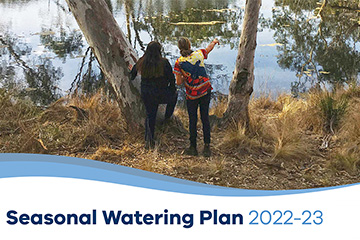Building on bird breeding boom
06 December 2016
Environmental water is being released into Barmah Forest wetlands to support the waterbird breeding boom triggered by the recent high natural Murray River flows.
Flows in the Murray River downstream of Yarrawonga are receding after peaking in early October around 178,000 ML/d.
"These high flows inundated most of the 66,000ha Barmah-Millewa Forest downstream of Tocumwal for the first time since 2010, promoting widespread waterbird breeding and a significant vegetation response," Goulburn Broken Catchment Management Authority's (CMA) Keith Ward said.
Waterbird species confirmed to be breeding in Barmah Forest this year include eastern great egrets (the only known location in Victoria), Nankeen night herons, little pied cormorants, little black cormorants, Australian white ibis, straw-necked ibis, royal spoonbills, white-necked heron, Pacific black duck, grey teal, black swans, swamphens and forest kingfishers. Australasian bitterns, little bitterns and musk ducks are also believed to be breeding as they have been heard calling in various wetlands throughout the forest, but their nests are notoriously difficult to locate.
"However, wetland depth is now rapidly falling due to river regulation and drier warmer weather, threatening a successful outcome to the current bird breeding and plant flowering events," Mr Ward said.
"Release of environmental water from Hume Reservoir will help maintain some shallow inundation of key wetlands by ensuring that the river does not fall below 15,000 ML/d until mid to late-December. Without this environmental water in the wetlands, many thousands of waterbirds are likely to abandon their nests, leaving flightless young birds to die."
The forest's wetlands contain significant endangered and internationally recognised vegetation communities, including Moira grass plains and river swamp wallaby grass, which will also benefit from the environmental water releases.
This vegetation is important as it provides vital food and shelter for waterbirds, frogs, turtles, fish and other animals.
"The environmental water may also go some way to mitigating the impacts of a blackwater event that developed after the natural flooding, by increasing dissolved oxygen levels in the river downstream of the forest," Mr Ward said.
"This will improve conditions for native fish."
The vast majority of the flow diverted into Barmah Forest will pass through the wetland system and return to the Murray River further downstream where it can then be re-used for other purposes. Environmental water delivery also takes into consideration delivery orders by irrigators and other water users.
The environmental watering events have been planned by the Goulburn Broken CMA in consultation with Parks Victoria, Yorta Yorta Nation Aboriginal Corporation and the Murray Darling Basin Authority, as outlined in the Victorian Environmental Water Holder's Seasonal Watering Plan 2016-17.
Further Information
Goulburn Broken CMA
E: reception@gbcma.vic.gov.au
Tel: 03 5822 7700


